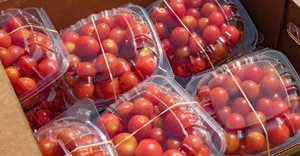We need to work to increase recycling rates, both here in America and across the world. Events like America Recycles Day remind us that while consumers do play an important role towards increasing recycling, more work must be done by environmental stakeholders, industry, and government to make that happen. We know that there are solutions available to meet our shared sustainability goals on recycling as well as specific actions we can take to get it done, together.
November 16, 2023
Patrick Krieger, Vice President of Sustainability, Plastics Industry Association
America Recycles Day and Plastics Recycling Week are reminders that reducing, reusing, repurposing, and recycling materials improves our environment every day. This is especially important for materials like plastic that are essential and make our world better. Plastic reduces greenhouse gas emissions by minimizing food waste, makes the efficiency of electric vehicles possible; not to mention EV batteries, protection for healthcare workers and lightweight properties that conserve energy throughout its lifecycle. But just because we experience strong benefits at other parts of the lifecycle doesn’t mean we can ignore creating and improving circular end-of-life options.
We need to work to increase recycling rates, both here in America and across the world. Events like America Recycles Day remind us that while consumers do play an important role towards increasing recycling, more work must be done by environmental stakeholders, industry, and government to make that happen. We know that there are solutions available to meet our shared sustainability goals on recycling as well as specific actions we can take to get it done, together.
First and foremost, we need accurate and up-to-date data on recycling rates in U.S. The last time the Environmental Protection Agency updated numbers on recycling was in 2018—nearly six years ago. If we are truly committed to increasing recycling and protecting our environment, we need current data to understand the full picture, thus enabling us to determine if interventions have been successful. Recycling data should be provided on at least an annual basis and should not only include national data, but also state-specific information.
We must continue to bring public attention to the positive outcomes of recycling through education, an important focus as it encourages the public to act with environmental awareness, yet that’s still not enough. Recycling needs to be easier and more accessible. Only half of households in the U.S. have automatic access to curbside recycling. In multifamily dwellings only about 30-40% have access to recycling – the ability to recycle itself needs to be more accessible to every American. For products that cannot be recycled through curbside, access should be available through alternative channels like store or community drop-off. And to that end, we are reminded that recycling goes way beyond our households. In Washington, D.C., where laws on the books require public establishments recycle, the commercial recycling rate is 7%. Mandatory commercial recycling should be increased, established, and enforced in locales so people can recycle whether they are at home, at work or away.
The recycling infrastructure in the United States also needs major improvement. Simply put, recycling systems haven’t evolved with the incredible innovations in materials and products. Improved infrastructure will allow for even more recyclable material to be collected and used in everyday products like electronics, water bottles, clothing, and many others. Our industry understands we have a role to play in funding improved infrastructure and has invested more than $8 billion since 2017 to improve recycling. It’s why we also support well-constructed extended producer responsibility programs, which enables industry to directly support recycling systems. It’s also why the plastics industry supports attainable minimum recycled content requirements that establish guaranteed end-markets for material and in turn, spur private investment.
Increasing recycling rates, improving sustainability and circularity, and protecting our environment, all require a global effort. We know we can’t achieve our common goals without acting together and all of our efforts must be done in a collaborative manner. That means multiple levels of government, along with the private sector and communities working together. That spirit of collaboration is the message our industry will echo throughout the Global Plastics Treaty discussions in Nairobi this week and one that we will continue to support here in America. Let’s work together towards real, impactful change for a cleaner, more sustainable environment.
Patrick Krieger is vice president of sustainability at the Plastics Industry Association.
You May Also Like


